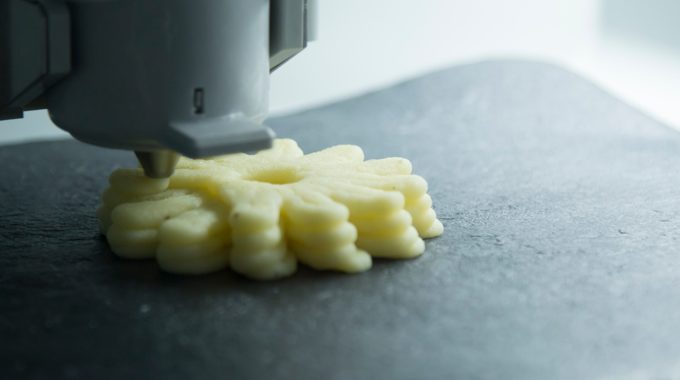3D printed food: better health, less waste
Researchers from Edith Cowan University are using innovative food technology to boost the fruit and veg intake of Australians while also reducing food waste. By creating 3D printed food, the tech aims to make meals more interesting and more enticing to groups who may not get their daily two and five. And by using surplus produce that would normally go to waste, the process can help to slash the amount of food that ends up in landfill.
The produce is chopped, freeze-dried and pureed to create “inks”. Using these, the researchers are able to build 3D printed food in a variety of enticing designs. These custom-designed meals can either look like the real thing, such as pea purée printed into the shape of peas. Or they could resemble animals, spacecraft or abstract geometric shapes.
Making nursing home food more enticing
ECU Institute for Nutrition Research (INR) Postdoctoral Research Fellow Dr Liezhou Zhong says up to two-thirds of older Australians in residential aged care suffer from malnutrition. This is a leading indicator for frailty and a variety of other health conditions.
“Residents in aged care who experience problems chewing or swallowing often eat a texture-modified diet, where food is puréed,” he says. However, minimal time, money and effort is put towards making the food look or taste good.
Dr Zhong believes part of that problem is that residents find puréed meals unattractive. He says the challenge is to make these meals closely resemble the original raw product.
“For residents on texture-modified diets, if we make meals more appealing, they’ll be more likely to eat them,” he says. “This can help to avoid malnutrition. We believe this project is the first to focus on using 3D printing with fruits and vegetables,” he says.

Getting kids excited about food
INR researchers are also using 3D printed food to help primary school children better understand nutrition. This also teaches them how technology can play a role in what we eat. Research Fellow Dr Dammy Adu says she hopes to develop students’ interest in healthy eating through the ability to print food into different designs.
“Increasing students’ food literacy is vital to improving diets and other future health outcomes,” she says. “Students learn about core concepts of science, technology and maths in a fun setting where we can incorporate nutrition and health-related topics.
“This project also teaches them about sustainability by using ‘ugly’ and imperfect produce to teach students about food waste and finding innovative uses for that produce.”
Dr Adu’s project is bringing students onto ECU’s Joondalup Campus to learn directly about 3D printed food. The project is also visiting schools around WA. She hopes to develop educational resources to allow similar projects to teach students around the country.

Finding solutions to food waste
3D printed food also helps to reduce food waste by using misshapen or blemished produce deemed unsuitable by retailers. Dr Zhong says there is huge potential for using this lower-grade produce in the institute’s research projects.
“We can use these ugly fruits and vegetables because the produce we’re using is puréed,” he says. “So it doesn’t matter what it looks like.”
“We’re working with chefs, farmers and producers to ensure food that would normally go to waste can find a use. But importantly, it still tastes and looks good.”
INR researchers want to hear from producers, aged care providers and schools interested in exploring 3D printed food. For more, go to the Institute for Nutrition Research webpage.









